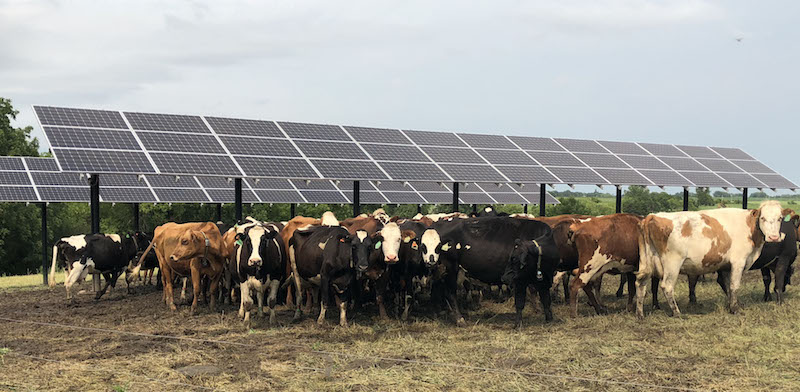Indeed, agrivoltaics projects are springing up across the globe, especially in Asia. Germany’s Fraunhofer Institute for Solar Energy Systems (ISE) estimates that by 2021, more than 14 gigawatts (GW) of agrivoltaic (or agriPV) systems had been installed, thanks to supportive government policies in Japan, South Korea and China, for example.
Higgins suggests that the best conditions for solar panels are precisely the conditions that are best for agricultural crops. Critically, solar panels and biomass don’t compete for the same available light, as both use different frequencies of the visible light spectrum.
Indeed, agrivoltaics projects are springing up across the globe, especially in Asia. Germany’s Fraunhofer Institute for Solar Energy Systems (ISE) estimates that by 2021, more than 14 gigawatts (GW) of agrivoltaic (or agriPV) systems had been installed, thanks to supportive government policies in Japan, South Korea and China, for example.
Higgins suggests that the best conditions for solar panels are precisely the conditions that are best for agricultural crops. Critically, solar panels and biomass don’t compete for the same available light, as both use different frequencies of the visible light spectrum.
His colleague, Maggie Graham, demonstrated that wildflower blooms were delayed if grown under solar panels, providing forage for pollinators late in the summer, when usually there was a dearth of blossom. So, even a simple meadow habitat under solar panels can assist agriculture and biodiversity by supporting pollinators.
Solar panels can help protect crops from extreme temperatures and reduce water consumption. On the flip side, says Higgins, plant activity helps cool the panels. “They’re like any other electronic device, they become more efficient as they become cooler – so it can be a truly symbiotic relationship.”
In Europe, a flurry of projects has been announced, and the EU has set ambitious new targets for solar energy as part of its efforts to move away from Russian gas imports. A major thrust is rooftops, but multiple use of space – such as through agrivoltaics – is also targeted.
Spanish energy group Iberdrola has won four government contracts in France that will provide 12 megawatts (MW) of solar power, with the price of energy guaranteed for 20 years, while TotalEnergies has just reported preliminary results from a first year of harvests at three sites in France.
At one site, panels are placed vertically, and researchers are exploring their impact on rotations of crops such as wheat, barley and lentils. A second demonstrator incorporates a solar canopy system developed by TSE, with panels sited high above the crops.
Alizée Loiseau, an agronomist at Agrosolutions who has been working to analyse the early results, says the locations in eastern France were chosen because “agriculture is becoming more challenging (and) soils are less resistant to drought”.
Potentially, she says, even “if it’s a bad year (for harvests) farmers still have an income ‒ it’s very important to stabilise the farms from an economic point of view.” The average age of a French farmer is 53, so there’s serious interest from local authorities and agriculture cooperatives, who want to ensure there will be economically viable farms for the next generation to take over.
Designing a solar array to maximise crop and energy yield takes thought, to meet both the needs of farmers and to keep costs down. Stephan Schindele, who heads up agriPV product management at Germany’s BayWa r.e, points out that “it was a 10-year learning process to integrate solar panels onto rooftops – and now it’s standard. Nobody thinks about it (now), but it wasn’t so easy in 1995. And now, when we go large scale onto farmland, we’re in the same learning process,” He added: “But it’s not rocket science, so I’m pretty confident we’ll be able to merge and leverage synergies between the two.”
BayWa r.e. has an array of pilots across Europe and a couple of commercial-scale projects that focus on soft fruit crops. At one of these, in the Netherlands, raspberries grow under semi-transparent panels that shelter the berries from extremes of weather and are sturdier and more sustainable than plastic polytunnels.
The panels generate over 2.6MW of peak solar power – enough to provide clean energy to more than 1,000 households. At its first installation in Spain, 10% of the 5MW solar park BayWa r.e is about to finish building, is given over to agriPV. A power-purchase agreement with roof window manufacturer Velux will see it take 80% of the electricity generated, with the remainder added to the grid. The solar panels will also collect water to store for use in the arid summer months.
But both Schindele and Loiseau note that it can take years to get permitting. The first project Loiseau worked on, in 2019, still hasn’t been built. “Social acceptance (and) visibility have to be taken into account,” she adds.
“We’ve really got to speed up things, that’s for sure,” agrees Schindele. “Policymakers have to adapt and reduce the barriers that we are facing in the solar sector.” He wants to see coordinated action across ministries dealing with agriculture, energy and finance to address the multiple crises of energy, food and climate. “If you only think in silos, you don’t get there.”
Permitting can be easier where there are agreed definitions and standards. For example, in Germany, experts at the Fraunhofer ISE have developed a standard covering the planning and development of installations, as well as operations and monitoring; whilst in Italy national guidelines drawn up last year specify the continuity of agricultural production, as well as levels of electricity production. Water consumption, crop yields and soil fertility must all be monitored.
Getting agrivoltaics projects off the ground will require some financial support because they’re more expensive than ground-mounted solar arrays. Just how much more depends on the configuration, but researchers are seeing that they can be profitable. Calculations by experts at Fraunhofer ISE put the increase in the levelised cost of electricity (including building and operating a project) at anywhere between 20% and 60% higher than ground-mounted solar PV.
While Oregon University’s Higgins warns that agrivoltaics are not a panacea, lessons from projects around the world show they offer the potential to keep land in production as well as making crops and ‒ by extension ‒ farmers and food systems, more resilient to our changing climate.












